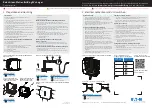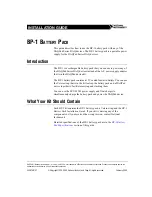
MUC108LC
4
rev. 09/09/09
MUC108LC 10.8V Li-ion Charger
SAVE THESE INSTRUCTIONS!
SAFETY INSTRUCTIONS FOR BATTERY
CHARGER AND BATTERY PACK
DANGER! READ CAREFULLY
120 Volts present at charging terminal. Absolutely DO NOT
probe with conductive objects.
1. CAREFULLY READ AND UNDERSTAND THESE
INSTRUCTIONS
This manual contains critical safety and operating
instructions for the tool, battery charger, and batteries .
2 . Before using battery charger, read all instructions and
cautionary markings on (1) battery charger, (2) battery,
and (3) product using battery .
3. CAUTION - To reduce risk of injury, charge only MATCO
rechargeable batteries marked on the charger label .
Other types of batteries may burst causing personal
injury and damage .
4 . Do not expose charger to rain or snow .
5 . Use of an attachment not recommended or sold by the
battery charger manufacturer may result in a risk of fire,
electric shock, or injury to persons .
6 . To reduce risk of damage to electric plug and cord, pull by
plug rather than cord when disconnecting charger .
7 . Make sure cord is located so that it will not be stepped on,
tripped over, or otherwise subjected to damage or stress .
8 . An extension cord should not be used unless absolutely
necessary . Use of improper extension cord could result in
a risk of fire and electric shock . If extension cord must be
used, make sure:
a . That pins on plug of extension cord are the same number
size, and shape as those of plug on charger;
b . That extension cord is properly wired and in good
electrical condition;
c . That wire size is at least as large as the one specified
in the table below .
9 . Do not operate charger with damaged cord or plug -
replace them immediately .
10 . Do not operate charger if it has received a sharp blow,
been dropped, or otherwise damaged in any way;
take it to a MATCO AUTHORIZED service facility .
11 . Do not disassemble charger or battery cartridge;
take it to your MATCO AUTHORIZED distributor service
facility . Incorrect reassembly may result in a risk
of electric shock or fire .
12 . To reduce risk of electric shock, unplug charger from
outlet before attempting any maintenance or cleaning .
Turning off controls will not reduce this risk .
13 . The battery charger is not intended for use by young
children or infirm persons without supervision .
14 . Young children should be supervised to ensure that they
do not play with the battery charger .
OPERATIONAL GUIDELINES
FOR BATTERY CHARGER AND
BATTERY PACK
1 . Do not attempt to use a step-up transformer, an engine
generator or DC power receptacle .
2 . Do not allow anything to cover or clog the charger vents .
3 . Always cover the battery terminals with the box or cover
when the battery cartridge is not used .
4 . Do not short the battery cartridge:
(1) Do not touch the terminals with any conductive
material .
(2) Avoid storing battery cartridge in a container
with other metal objects such as nails, screws,
coins, etc .
(3) Do not expose battery cartridge to water
or rain . A battery short can cause a large current flow,
overheating, possible burns and even a breakdown .
5 . Do not store the tool and Battery Cartridge in locations
where the temperature may reach or exceed
50°C (122°F) .
Table 1: RECOMMENDED MINIMUM AWG SIZE FOR
EXTENSION CORDS FOR BATTERY CHARGERS
Length of Cord (Feet)
25 50 75 100 150
AWG Size of Cord
18 18 16 14 12
6 . Do not incinerate the Battery Pack even if it is
severely damaged or is completely worn out .
The battery cartridge can explode in a fire .
7 . Be careful not to drop, shake or strike battery
as it will affect the capacity and may void warranty .
8 . Do not charge inside a box or container of any kind .
The charger and battery are ventilated devices and
must NOT be placed next to a heat source or in
exposure to radiating heat .
9 . Place charger on a solid and sturdy surface as there are
vents on the bottom side of the charger .
10 . Always unplug the charger from the power supply when a
charging sequence is not taking place .
FAILURE TO OBSERVE THESE WARNINGS COULD RE SULT IN IN JU RY.





































